Related Links
How to Prepare Fruit Trees for Winter
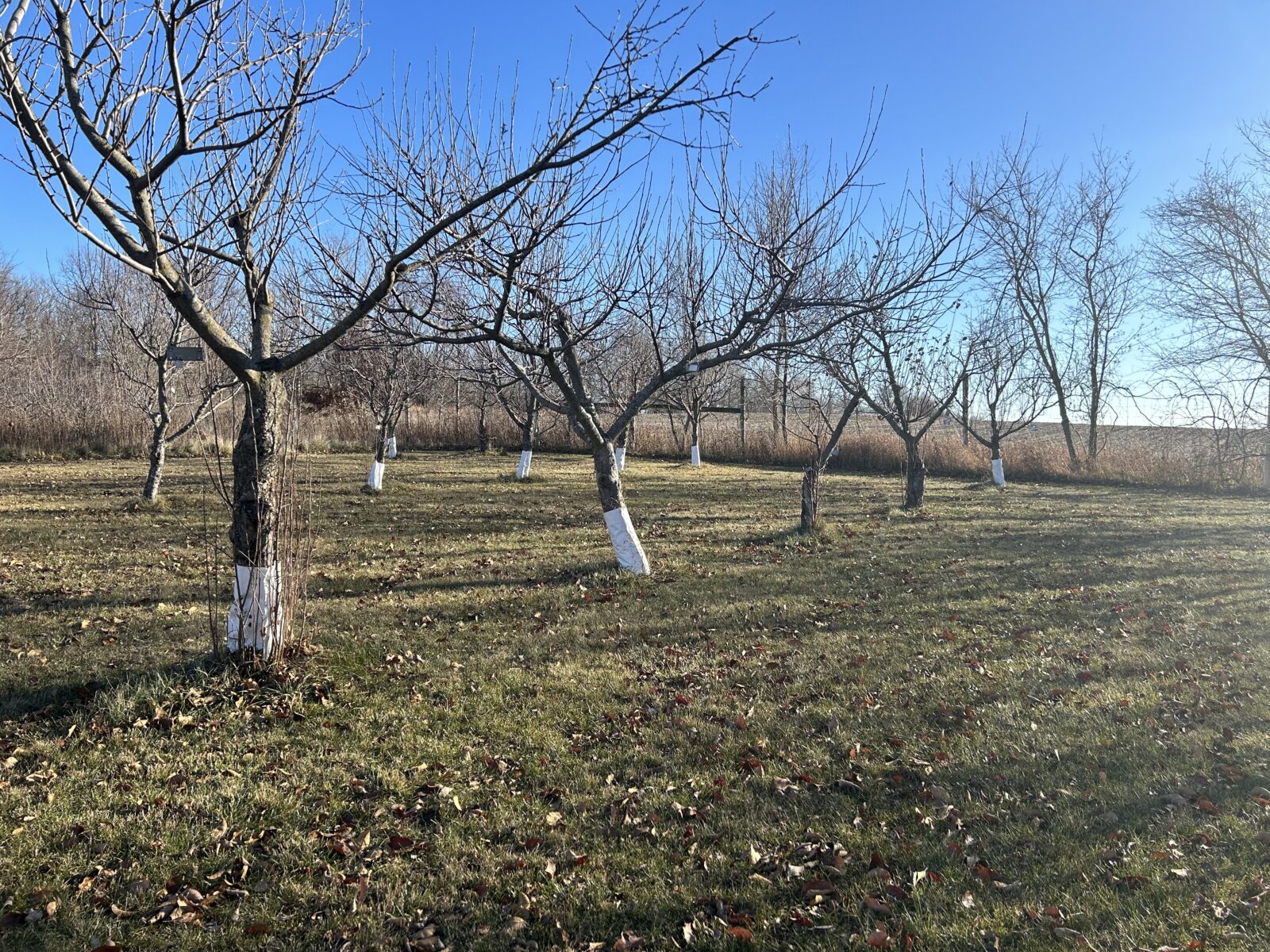
How to Prepare Fruit Trees for Winter
When there’s a distant chill in the air, it’s time to prepare fruit trees for winter. Properly winterizing young trees is essential for their protection from animals and disease. With proper tree care, your fruit trees will survive the winter. Tree guards and fences are the best methods to protect your trees from animals.
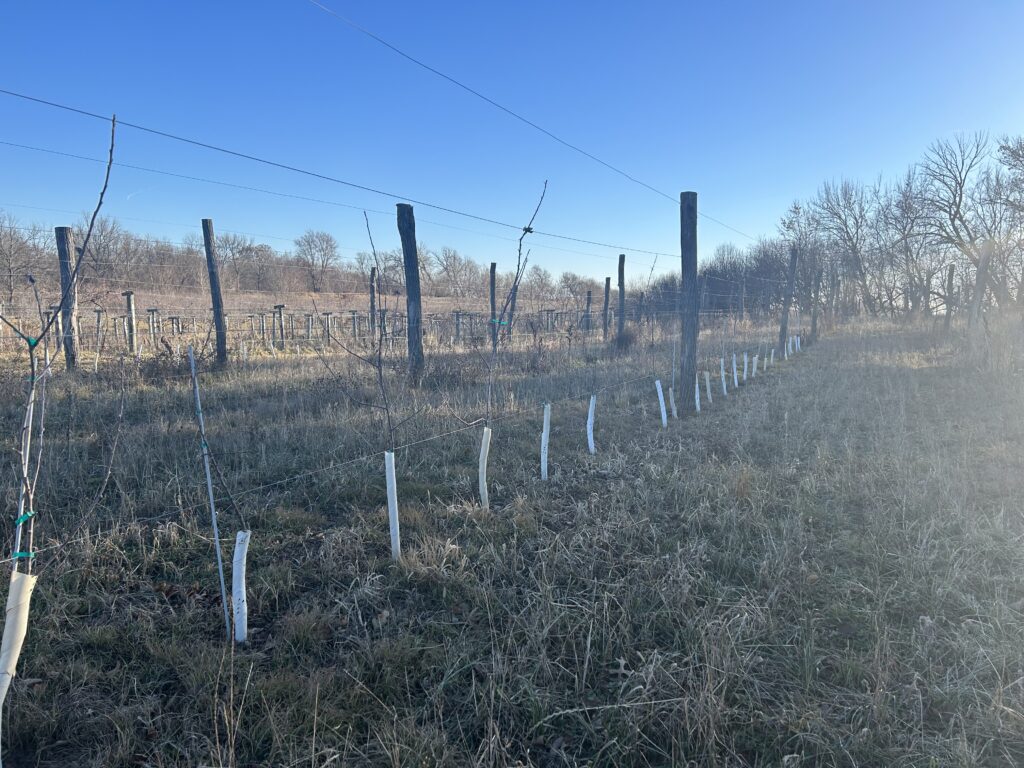 Nursery trees protected with spiral vinyl tree wraps
Nursery trees protected with spiral vinyl tree wraps
Why Protect Your Trees?
Fruit trees are especially attractive to animals that love to eat the bark and nibble the buds for winter food. To avoid the time, energy, and financial cost of replacing trees year after year, implement a plan for deterring pests.
Many people assume deer are the worst culprits; however, mice and voles pose at least as great a danger to young trees. Mice and voles actually damage far more trees than do deer, especially young trees, as they girdle the trunk near the ground line, harming the tender bark. This damage is harder to detect until the following spring, and can cause your tree to stop growing.
Once a tree is six years old, it develops a tough outer bark that many mammals don’t find as palatable. However, small critters like mice have managed to decimate the bark of even large apple trees. All trees are susceptible to health problems such as disease and fungus.
Keep reading to learn how to protect your trees and so that they will continue to thrive.
Tree Protection from Rodents and Other Small Mammals
Mice, rats, voles, and rabbits can be detrimental to a tree, particularly when the tree is young and delicate. Tree guards are the only way to effectively protect your tree from small mammals.
Materials Needed
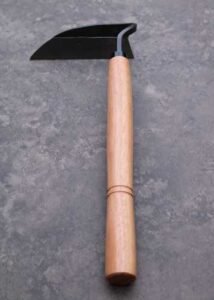
- A hand hoe, or other tool to clear the ground around the base of the tree trunk from grass and weeds.
- A tree guard to wrap around the tree.
- Some tree guards require staples or zip ties to secure the guard around the tree.
- Hardware and garden stores, such as A.M. Leonard Tool & Supply Co., are great sources for tree guards. Homemade options are also possible.
- Pruning clippers to clear shoots and leaves from the lower trunk.
How to Choose a Tree Guard
Installing a tree guard is easy and can be inexpensive. Tree guards have both commercial and homemade options; however, no guard is a one-size-fits-all solution. To choose a guard for your tree, consider its years of growth.
Less than 5 years: Use spiral vinyl wraps to protect trees with less than five years of growth, but be sure to remove them before the summer. Sunscald can easily damage young trees, so it is important not to fit them with mesh guards.
5 to 10 years: Use a tree tube or a plastic mesh guard once fruit trees have at least five years of growth and are sturdier. Plastic mesh guards are similar to tree tubes, but have airflow so you can keep them on the tree throughout the year.
10 years or more: Consider a tree guard made from hardware cloth once trees have at least 10 years of growth and are showing mature bark.
You should protect a tree over the course of its entire life. Wrapping the trunk in a roll of Tyvek will give your large, old trees the protection they need. Since these wraps restrict airflow and can harbor humidity, only use a Tyvek wrap in the winter. Even small amounts of damage from rodents can create openings to harbor disease.
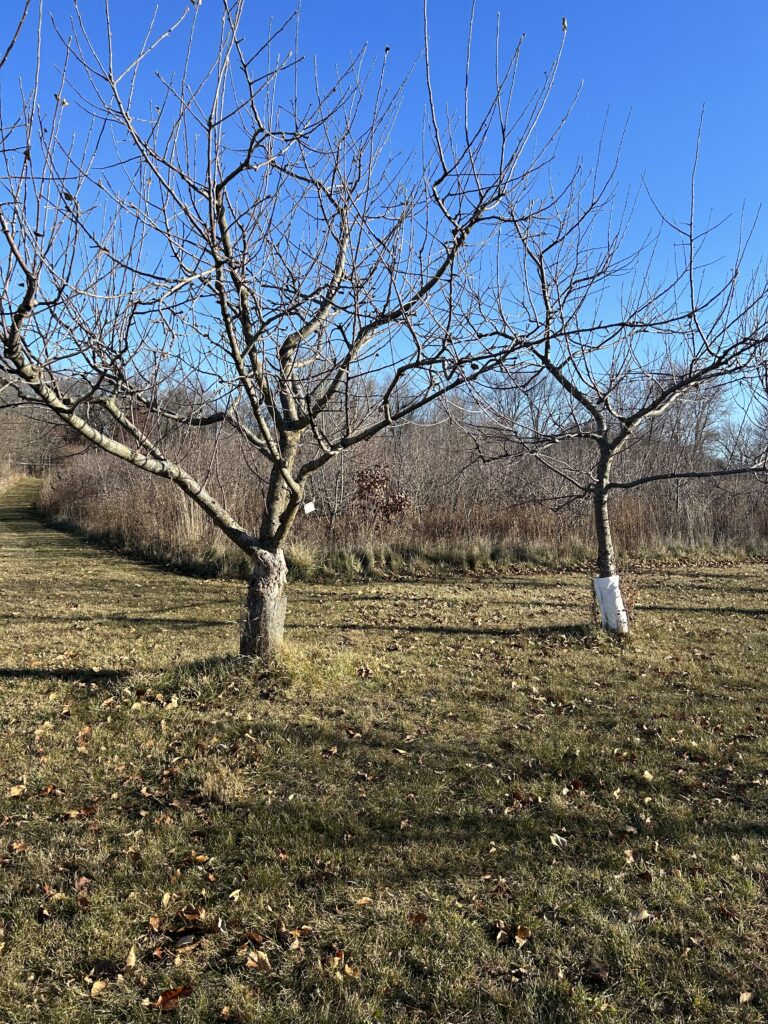
How to Install a Tree Guard
Install a tree guard when your tree is dormant or nearing dormancy (when the leaves have fallen and other vegetation has died back). All tree guards, regardless of material, should extend all the way to the ground, preferably at least one inch below the ground surface.
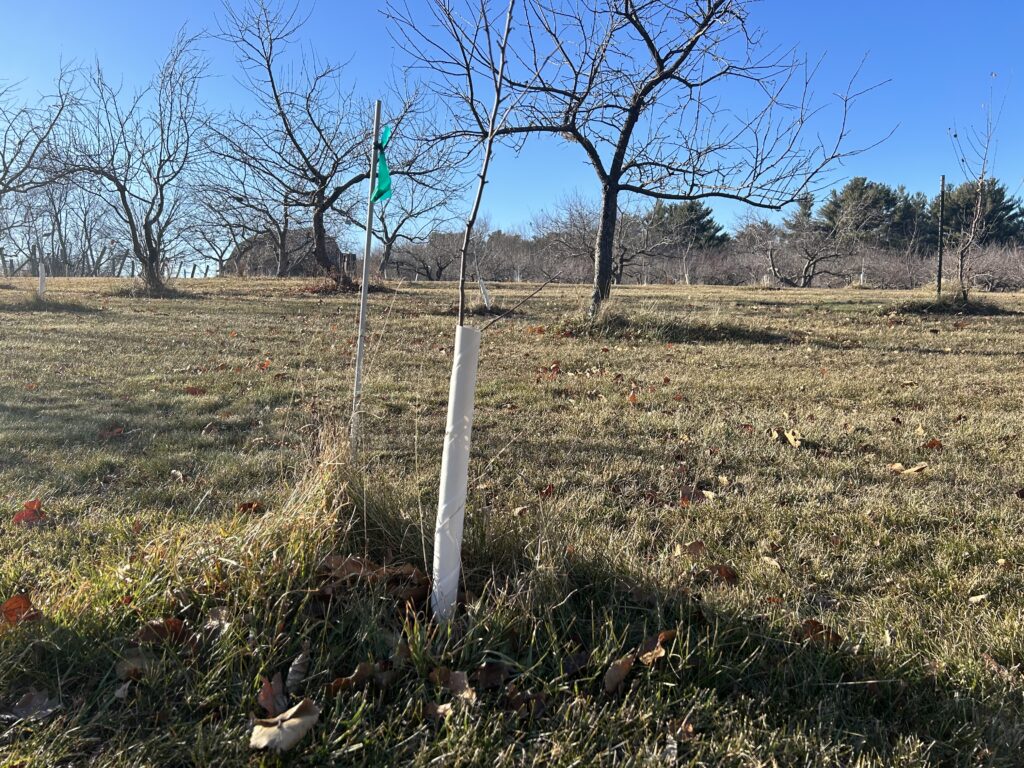
Spiral vinyl wraps are simple to install and commercially available. They usually come in both 24-inch and 36-inch lengths with a 1 ½ inch diameter, but you can cut them to fit for height. They are generally sunlight sensitive and become brittle after a few years. Take these steps to install a spiral vinyl tree guard:
- First, use a hand hoe to clear the ground around the base of the trunk. Clear enough space for the tree guard to fit. Nothing should be where the tree guard wraps around the tree and reaches the ground.
- Next, use pruning clippers to cut any shoots or leaves that would be within the tree guard. Leaves within a tree guard raise humidity and may harbor disease over winter.
- Start at the base and wrap the tree guard around the trunk, making sure there are no gaps with exposed bark. This prevents pests from getting underneath the wrap.
- Twist the wrap at least one inch into the ground to make it secure.
- Finally, pat some extra soil or mulch around the base of the tree to discourage critters from digging under the guard.
- Do not leave these tree wraps on your tree year round, as they restrict airflow and can harbor humidity and disease. If abandoned, these wraps can also girdle into the trunk.
Tree tubes are effective to protect trees that have at least five years of growth. These plastic commercial tubes usually have a latching system to secure the guard. Take these steps to install a tree tube:
- Follow the directions above for clearing and pruning.
- Wrap the tube around the tree and secure it with staples for additional security.
- Secure the tube by pushing it into the soil and pat extra soil or mulch around the base.
- Do not leave tree tubes on your tree year-round. These wraps restrict airflow and can harbor humidity and harmful diseases.
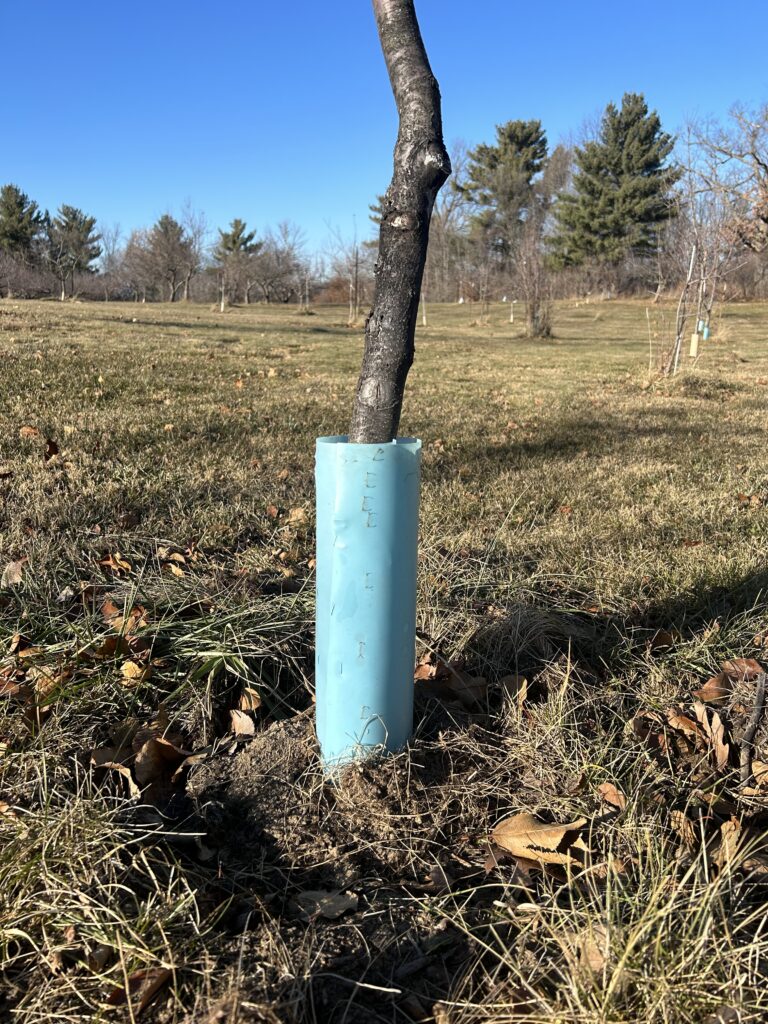
Plastic mesh guards also effectively protect trees with at least five years of growth. Unlike tree tubes, however, you can leave these guards on year-round because of increased airflow. Take these steps to install a commercial plastic mesh guard:
- Clear the area around the base of the tree and prune if necessary using the instructions above.
- Wrap the guard around the tree and secure it with zip ties.
- Push the guard into the soil for additional security and pat mulch around the base.
- You can leave this long-lasting guard on your tree year-round because of its great airflow. However, the tree is still susceptible to health issues and damage. Check on the tree’s trunk at least once a year for any problems obscured by the guard.
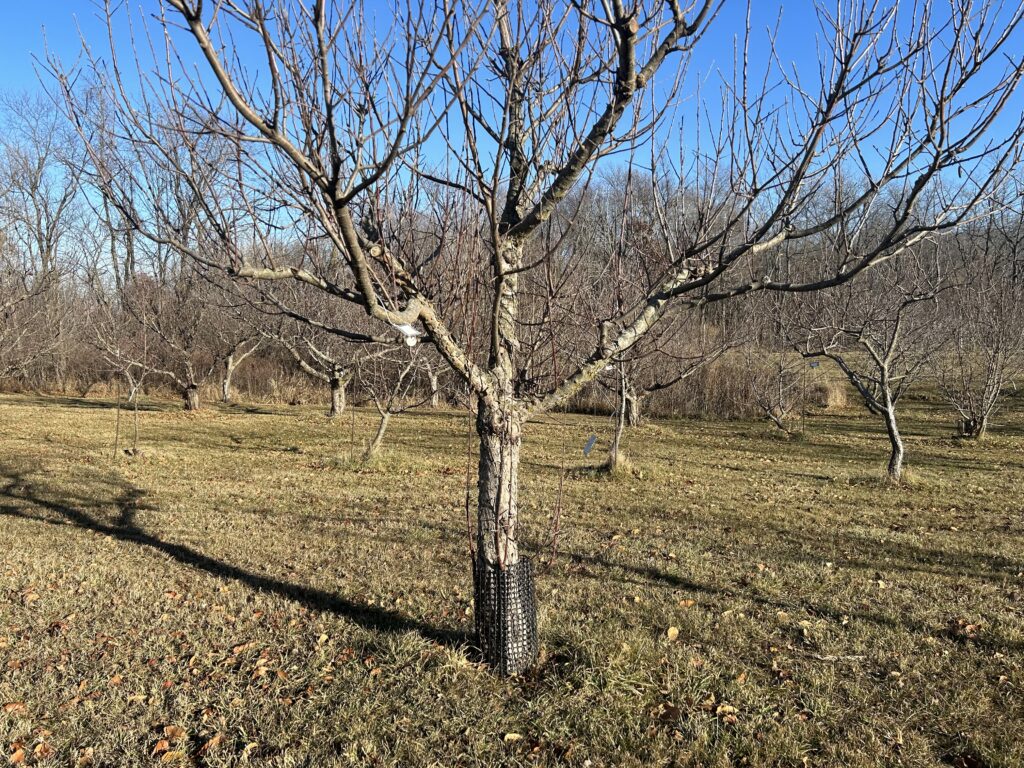
Hardware cloth is commercially available and easy to make into a tree guard. Consider a hardware cloth guard once the tree has reached 10 years of growth, or starts showing mature bark.
Hardware cloth/mesh is effective as long as the mesh size is not larger than ¼ inch. Take these steps to install a guard made of hardware cloth.
- Select hardware cloth with a mesh size ¼ inch or less and cut the cloth to fit around your tree.
- Clear the area around the base of the tree and prune if necessary using the instructions above.
- Wrap the hardware cloth around the tree, pushing at least an inch into the ground for security.
- Secure the guard with zip ties.
- Pat mulch around the base of the guard to further deter pests.
- You can leave this long-lasting guard on your tree year-round because of its great airflow. However, the tree is still susceptible to health issues. Check on the trunk at least once a year for potential issues such as disease or damage to the tree.
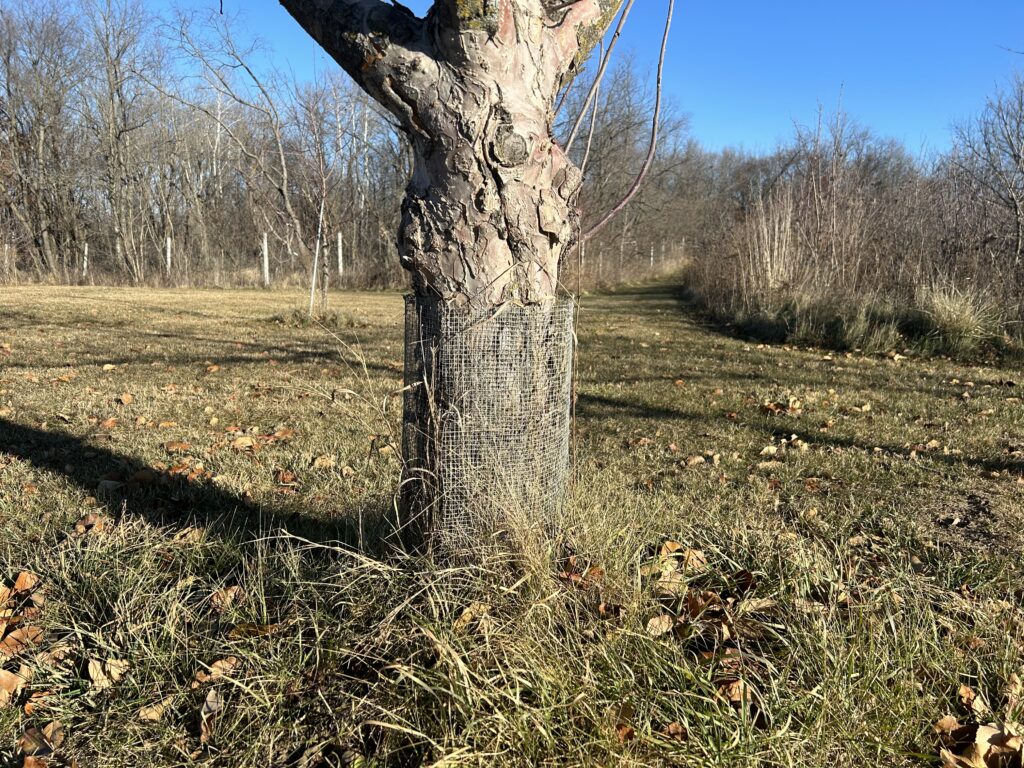
Although mature trees are able to withstand the occasional nibbles from small pests, mice or pack rats can still decimate even large trees. Use a tree guard even on mature trees and when using a perimeter fence.
Homemade Tree Guards:
Old window screening is excellent for a homemade tree guard. Use metal screening as rodents can chew through plastic screens.
Chicken wire is effective as long as the mesh size is not larger than ¼ inch.
Corrugated cardboard from packing boxes has crevices that attract and trap harmful insects. However, cardboard is not weather resistant and will decay quickly at the ground line. You will need to replace this option often.
Plastic soda bottles are a creative alternative material. You can use almost any material that is rigid as a solution for some protection. Be sure to press the homemade guard firmly into the ground. If the bottles are clear, use paint or add an opaque material to the guard to protect the tree from sun scald.
Consider Snowfall
If your area experiences snowfall, you may need to adjust the height of your tree guard. With heavy snow, animals will be able to reach the areas of your trees normally far above the ground.
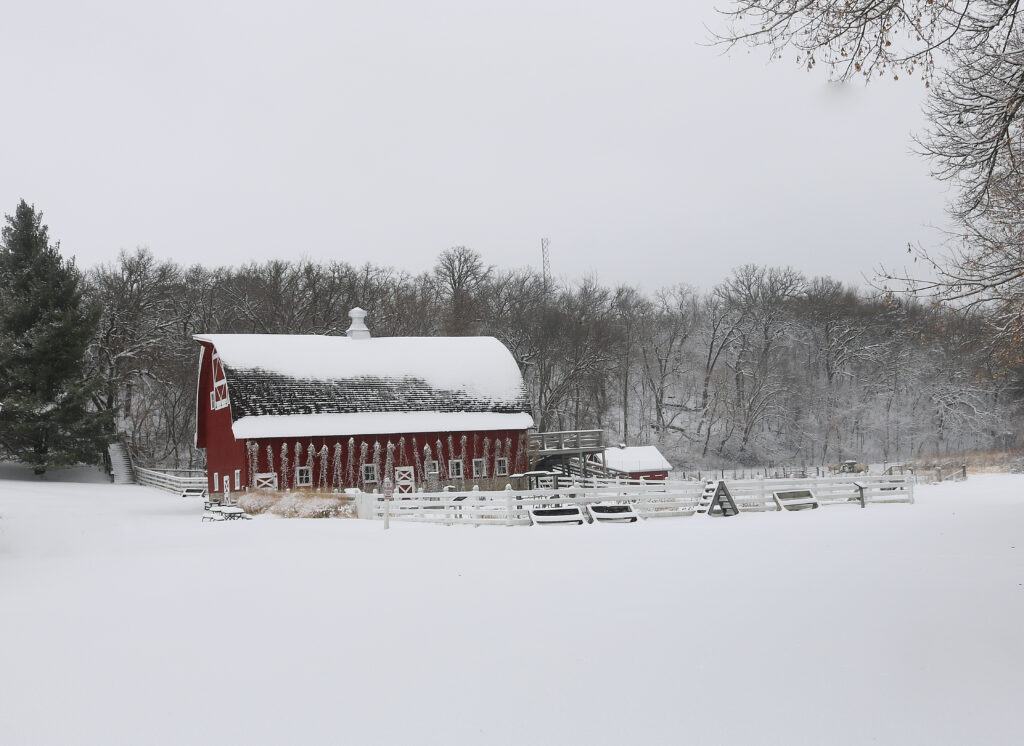
Use the average snowfall for your location and the height of your tree to help determine the necessary height of a tree guard. Make sure the guard will extend about 20 inches above the expected snowfall. In some cases, you may need to cover the entire young tree. Here at Heritage Farm in Decorah, our average snowfall reaches around two feet.
However, snow can also offer additional protection for your trees. Use snowfall to your advantage with this simple technique to further discourage voles and mice:
- After a snowfall, stomp the snow in a close circle around the trunk of the tree.
- Repeat for several additional snowfalls.
Compacted snow is a good deterrent, though not sufficient on its own.
Tree Protection from Deer
A tree guard will protect the trunk of your tree from smaller pests, however it will not protect the rest of your tree. Deer and elk will be able to also reach almost any young tree that is unprotected.
Most commercial orchards use fencing at least eight feet high to keep deer out. For the average homeowner, this kind of fencing can be expensive. However, tree protection is especially important in suburban areas where deer pressure can be higher than in rural areas.
Why not use liquid repellents over winter? Liquid repellents are easy to apply and deter deer with their unpleasant smell.
However, these wear off quickly and have limited ability to be effective throughout an entire winter. For orchards and larger gardens, reapplying the repellant can be costly and time consuming. Over time, some deer even acclimate to the taste and continue to forage from the tree.
The only reliable way to protect your trees from deer is with a physical barrier. Both individual fences and perimeter fencing are effective. Individual fences are great for protecting a small number of trees. Perimeter fences are best for large orchards of at least 10 trees.
Neither type of fencing will adequately protect a tree from small mammals. Use fencing in tandem with a tree guard.
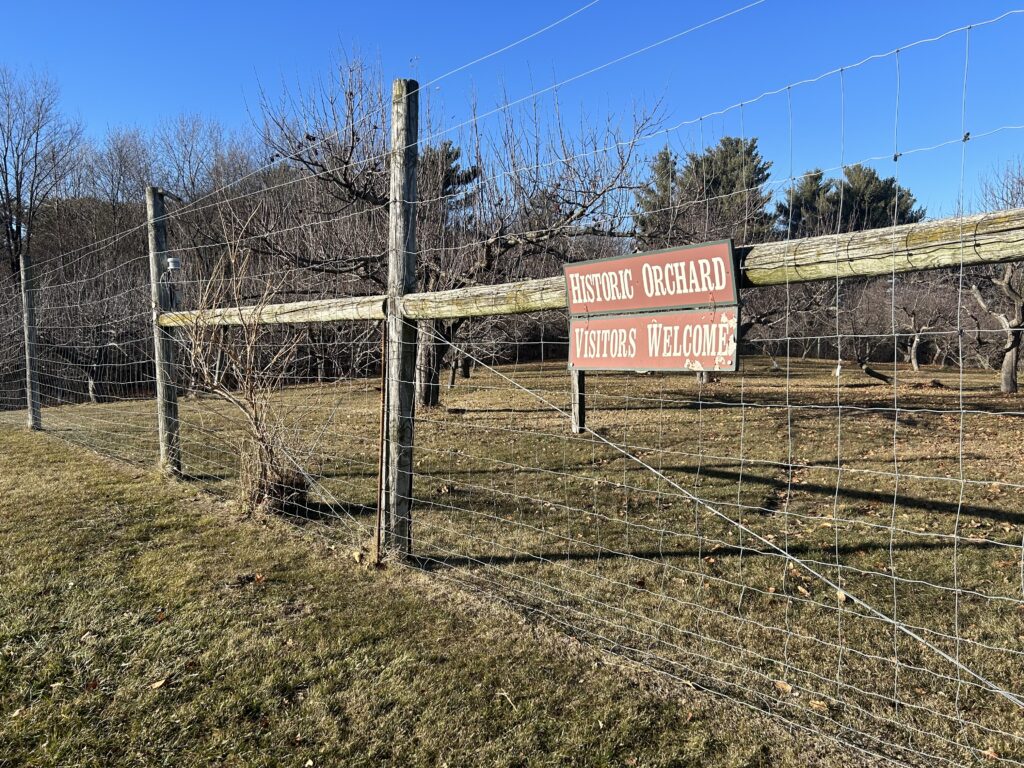
How to Install an Individual Deer Fence:
Putting up deer fencing can get expensive. Fortunately, there are cheap DIY methods to build a deer fence that are practical and effective.
One simple method for setting up a deer fence makes use of posts, PVC pipe, and clear 30-pound monofilament fishing line. Learn how to install a deer fence with fishing line.
An alternative method involves utilizing a sturdy material like poultry netting or woven fencing to build the deer fence.
Materials needed
- 3-4 T-posts or stakes to support the fence and hold it in place.
- Zip ties to secure the fence to the stakes.
- Rigid fencing material. Deer should not be able to push on the fence.
Poultry netting is effective and fairly low cost. Woven fencing from lumber suppliers is more durable and lasts longer. Follow these instructions to install a fence using chicken wire or woven fencing:
- Install three to four garden T-posts or stakes encircling the tree. This provides support to the fence and will keep the fence in place.
- Make a loop of chicken wire or woven fencing that is long enough to encircle the tree. Make sure the wire is tall and rigid enough to prevent deer from reaching over the fence.
- The 3-foot-high green or galvanized type of commercial woven fencing only offers minimal protection from deer. Use fencing that is at least 5 to 6 feet high.
- Wrap the fencing around the stakes and secure to the stakes with zip ties.
- Cut the wire with a pair of metal shears and secure by twisting back the cut ends over each other to interlock.
- Consider how you will access the tree. One idea is to create a latch system. Leaving some space between the base of the fence and the ground is okay when used in tandem with a tree guard.
How to Install a Perimeter Deer Fence
Individually fencing trees can become costly and impractical in orchards with more than 10 trees. In these cases, we recommend investing in a permanent perimeter fence.
- Make sure the fence you choose is at least 8 to 10 feet high, and keep in mind that deer are excellent jumpers. Here at Heritage Farm in Decorah, we have seen deer jump over a fence that stands eight feet tall.
- The fence should extend all the way to the ground.
- Add an entry point to the fence, preferably a large gate that can accommodate a vehicle.
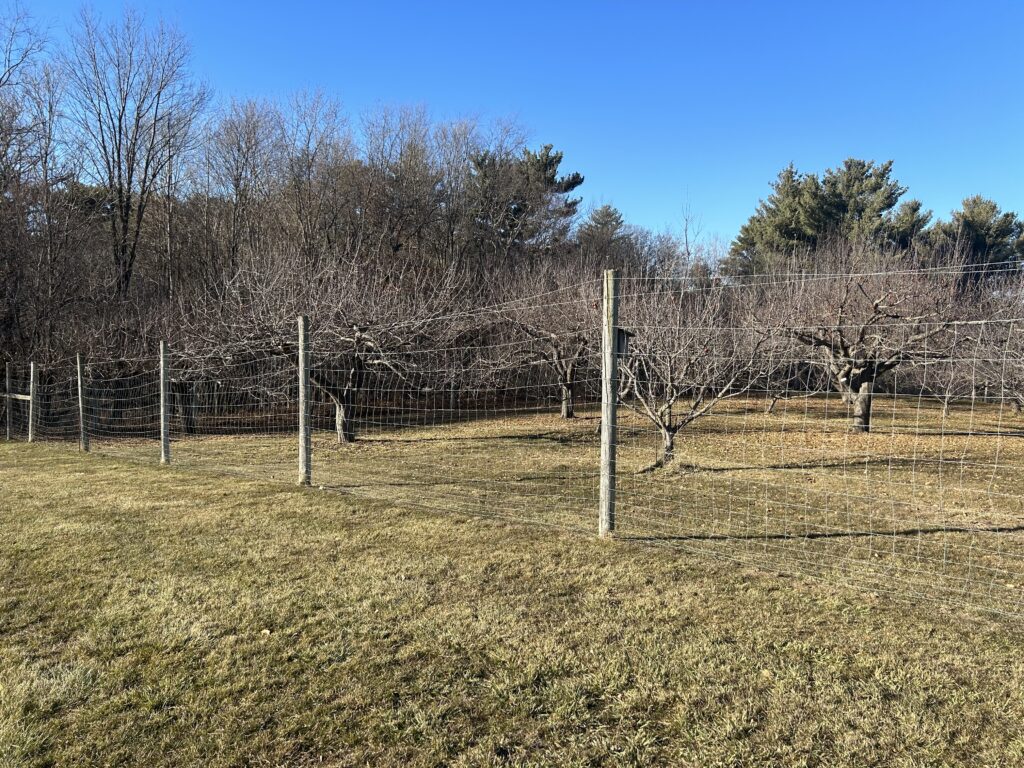
Protection from Pests and Fungi
Although mammals are a threat to young trees, installing tree guards and deer fencing will not guarantee a healthy tree. Insects, disease, and fungi can also cause damage to your tree.
Sanitation plays a key role in pest and disease management. Take these steps to protect your trees from pests, disease and fungi over winter:
- Clear windfall apples. Insects burrow into fruits (on the tree and on the ground) to lay their eggs. When the fruits fall, the insects and larvae enter the soil and can compromise the tree’s health.
- Take care of fallen leaves. Fungal spores will overwinter in fallen leaves. In the spring, the fungi put up fruiting bodies which send out microscopic, airborne spores. These spores can spread and infect your entire orchard; spores have traveled anywhere from hundreds of feet to over 1,000 miles away.
- Compost leaves as they fall, if possible for you and your space.
- Rake leaves into a pile and mow to accelerate decomposition and interrupt the cycle of fungal diseases.
- Mow again early in the spring. This turns over fallen leaves and interrupts the fungal spore cycle.
- Another option is to spray trees, organically or not. However, we always recommend natural methods before considering spray.
- Keep your tree healthy. Healthy trees with proper care are less susceptible to disease.
- Remove tree guards with inadequate airflow after the cold season. Leaving these on year-round can trap humidity, creating a breeding ground for disease.
- Occasionally check on the health of tree trunks. These trees may still be susceptible to disease and damage that the tree guard might obscure.
- Add mulch around your trees in a donut shape to help prevent sod-forming vegetation and root systems from growing around the tree.
- Mulch on its own does not protect against pests. In fact, rodents can burrow into mulch, particularly straw. However, mulch does facilitate optimal growing conditions for trees and protections from other root systems.
- Do not put mulch against the trunk of the tree.
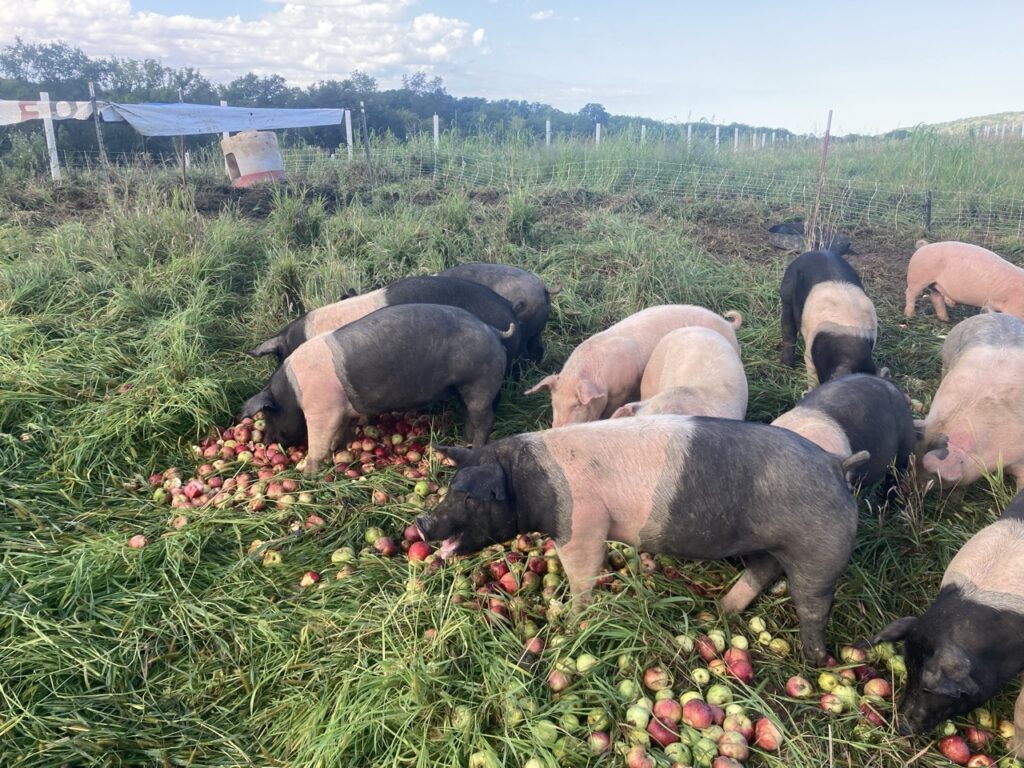
More Information
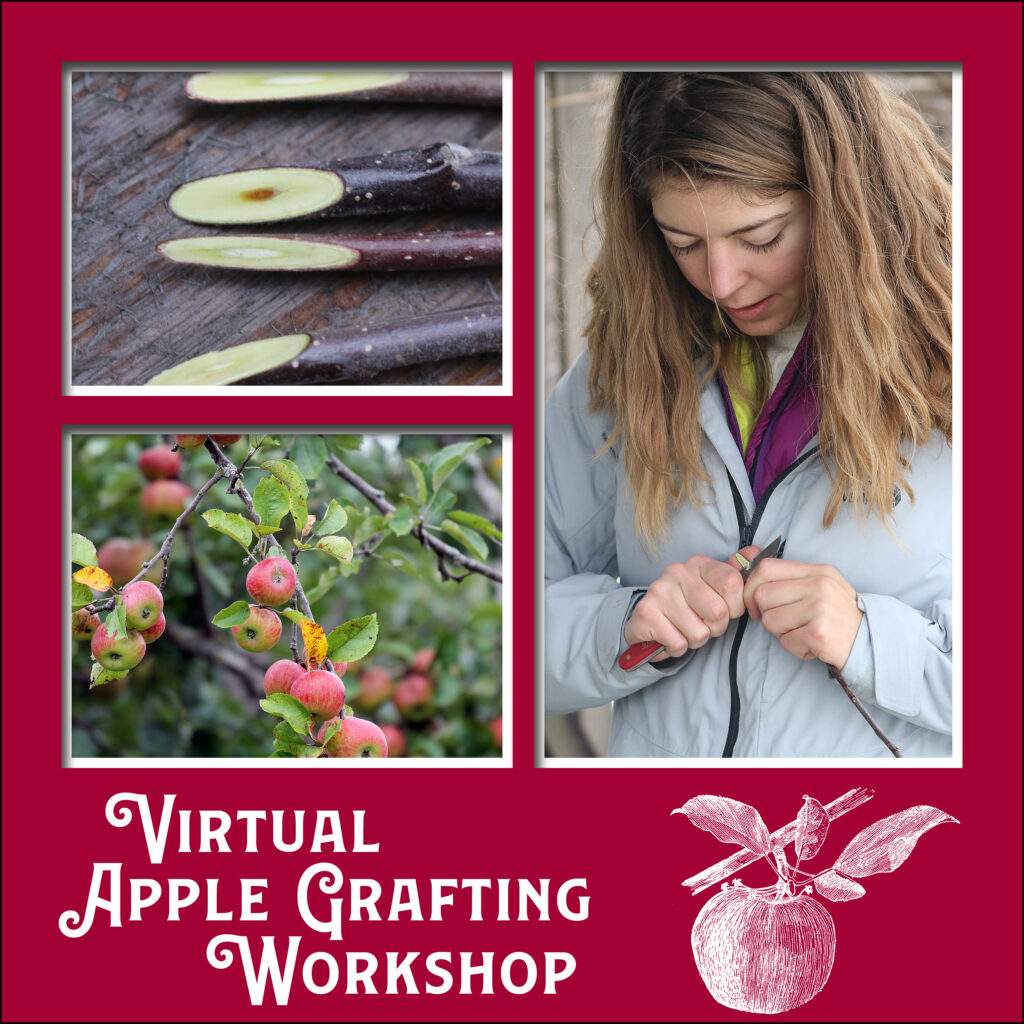
Seed Savers Exchange offers a yearly Apple Grafting Workshop in the spring.
Registration for the next workshop will open in early 2025. Be the first to know by signing up for our newsletter!
This article updates a piece previously published on the Seed Savers Exchange blog in 2014.